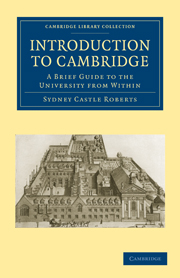III - ACADEMICA
Published online by Cambridge University Press: 10 November 2010
Summary
In the barest outline we have surveyed seven centuries of university history and have cast a rapid glance at the university and college buildings which those centuries have produced. How is the university organised and governed to-day? Though the university is older than the oldest college, it is now “almost impossible to conceive of the university apart from the colleges”. Through the colleges, which are themselves corporate bodies managing their own affairs, the university is supplied with its personnel; and while there are a few members of the university who do not belong to a college, every member of a college is a member of the university, and the normal candidate for entrance to the university must be admitted either through a college or as an approved non-collegiate student. The regulations for this formal admission, or matriculation, are a good example of the interaction of university and college. In the first place, the university accepts for matriculation only those who have already been admitted to a college or to the non-collegiate body; in the second place, the university requires that before a candidate may come into residence in a college he shall have passed the “Previous”, that is, the university entrance examination; in the third place, even when he has satisfied the university examiners, the college may also require him to pass a college entrance examination.
In this way some 1700 undergraduates (that is, students who have not “graduated”, or taken a degree) enter the university through the colleges every year.
- Type
- Chapter
- Information
- Introduction to CambridgeA Brief Guide to the University from Within, pp. 52 - 70Publisher: Cambridge University PressPrint publication year: 2009First published in: 1934



